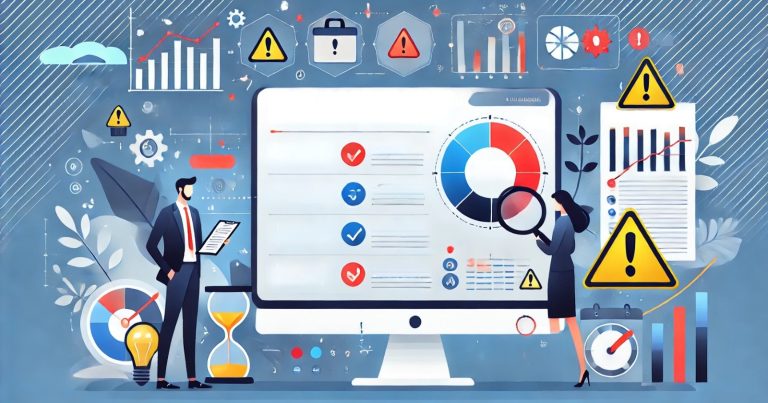Risk assessment example shows how organizations identify, analyze, and control risks that will maximize opportunities and minimize losses. Risk assessment helps identify all potential threats, hazards, and risks that may disrupt business in a structured manner and reduce its impact. An effective risk assessment plan example enables companies to travel in their respective fields smoothly. An example of a risk assessment report in the workplace, for example, or an information security risk assessment example, the process must be understood to make the best decisions.
What is Risk Assessment?
Risk assessment is a systematic method and set of processes for identifying, evaluating hazards, and implementing control measures to avoid or reduce adverse effects. Risk assessments are crucial in ensuring safety and compliance and safeguarding financial and operational stability within organizations.
- Recognizes risks in business activities.
- Avoid accidents and financial loss by taking preventive actions.
- Compliance in legal and regulatory affairs across industries
- Enhances decision-making with systematic risk assessment.
Risk Assessment Example
Various sectors demand individualized risk evaluations to uphold safety and adherence. Here are four risk assessment examples that show how organizations evaluate risks.
Workplace Safety Risk Assessment Example
A manufacturing company needs to evaluate risks in the workplace to avoid injuries resulting from working with heavy machinery, electrical hazards and exposure to chemicals. Regular maintenance of the machines, use of safety gear, employee training and ensuring that the machine meets safety standards are some measures that help reduce the risks involved. However, no action is taken without conducting inspections and monitoring safety protocols to ensure that preventive actions are working and the situation does not worsen. A structured approach to risk assessment means fewer accidents and increased or higher the chances of safety at work.
Information Security Risk Assessment Example
A business needs to protect critical data from cybeacks like unauthorized access, phishing attacks, and malware infections. Additional security technologies, such as firewalls and multi-factor authentication, along with cyber security training, can provide effective protection. A cybersecurity response plan allows you to act quickly if a threat is present. Security audits, and penetration tests supported by regular reviews, assist in aiding businesses to discover gaps.
Healthcare Risk Assessment Example
Hospitals must find ways to mitigate infection risks at the ICU by finding hazards such as contaminated medical equipment and inadequate hygiene. Preventive measures by regular cleaning, training of workers and disposal of waste control infection rate. The monitoring system with regular health audits should ensure that the hospitals follow the best level of patient safety.
Financial Risk Assessment Example
Banks must ascertain lending risks by detecting borrowers’ defaults, market changes, and fraudulent behavior. Checks, insurance for loans, and fraud detection systems reduce the risks. Banks can prevent losses, if they follow economic trends, so they can adjust the interest and lend accordingly.
Importance of Risk Assessment
Risk Assessment is a crucial process ensuring the safety, security, and financial health of multiple industries. To mention just a few critical areas, reduce workplace accidents and injuries, protect the data, and provide many more insights.
- Reduces Workplace Accidents and Injuries: Companies identify unsafe conditions and improve safety protocols. Cover legal and medical expenses in case of workplace accidents. An increase in safety training and inspections leads to a safer workplace.
- Protects Data and Cybersecurity: Security measures make it impervious to data breaches and cyberattacks. Ensure it aligns with the information security risk assessment example; Data security is strengthened through strong encryption and frequent system updates.
- Ensures Legal Compliance: Helps organizations comply with industry regulations and avoid legal repercussions. Ensures that healthcare, financial, and corporate sectors comply with safety standards. The best way to gain the trust of your customers and/or stakeholders is to follow proper compliance guidelines. General regulatory and compliance guidelines
- Avoid Potential Financial Losses: Anticipates the company’s ability to make financial decisions. Optimize investment risks and operational costs for companies. Having a risk strategy that is carefully planned can decrease the possibility of both unforeseen losses and improve financial stability.
- Enhances Decision-Making: Generates data-driven insights into risk management strategies. Helps organizations prioritize their resources. And this is the way you develop and maintain the business sustainably in the long haul.
Process of Risk Assessment
A systematic process for effective risk business risk management. This will help organizations fortify their safety and security frameworks through proper risk assessment. It is a controlled process through which risk assessment is done correctly and precisely. Following these risk assessment steps, organizations can develop a strong safety culture and institutional risk management system.
Identify Hazards
Hazard identification in risk assessment employers must perform workplace inspections and identify the risks to operations caused by machines, materials, or human errors. If, for example, within a warehouse context, heavy lifting is identified as an occupational health and safety concern that could contribute to a potential workplace injury. The data helps identify early potential safety hazards so they can be managed proactively.
Analyze Risks
Risk analysis entails establishing the likelihood of occurrence and its consequences on employees, business processes, and the bottom line. Companies have to assess how serious and how frequent a risk could be. For example, a retail store assesses the risks of customer injuries on wet floors and places safety signs that warn customers about such hazards. An appropriate analysis helps you to focus on higher risk areas.
Evaluate Control Measures
Review of control measures shows existing safety measures are sufficient. Companies should review current safety procedures and determine whether or not further protection is necessary. A hospital, for example, reviews the success of infection control procedures, thereby ensuring safety for customers and employees alike. This rakes in a sound and secure working environment throughout the guess iron.
Take Preventive Measures
Preventive approaches are designed to minimize or eliminate risks before they take place. Ensuring workplace safety. A structured approach companies need to create a structured plan and train employees to follow safe practices in the workplace. A construction company, for instance, mandates that employees wear helmet and safety harness. Based on this, what is the best course of action to take is prevention so that accidents are minimized.
Monitor and Review
At the same time, conducting constant monitoring and reacting to the results helps businesses stay alerted to new threats. It is necessary for organizations to continually review their risk assessment plans and update them as necessary. Monitoring on a continuous basis keeps up the businesses with the market trends, situations, and relevant updates impacting their operational efficiency.
Relevance to ACCA Syllabus
The topic of risk assessment is significant as it is included in both the Strategic Business Leader (SBL) and Audit & Assurance (AA) syllabus for the ACCA qualification. ACCA professionals should review risks such as financial, operational and compliance risks that can affect business performance. Risk assessment examples (such as credit risk analysis, financial misstatements, and fraud detection) will assist finance professionals in corporate governance and risk mitigation.
Risk Assessment Example ACCA Questions
Q1: How a company recognize the risk of financial statement misstatements in its reporting as a result of complex accounting policies? What type of risk is this?
A) Compliance Risk
B) Operational Risk
C) Market Risk
D) Strategic Risk
Ans: A) Compliance Risk
Q2 Give an example of operational risk in risk assessment?
A) A malfunction in the supply chain resulting in delayed production
A) A competitor releasing a new product
C) Higher tax rates imposed by the government
D) A decline in a company’s share price
Ans: A) Disruption in the supply chain resulting delayed production
Question 3: How does an organization assess the risk of fraudulent financial statements?
A) Forensic audit
B) Immunize from financial reporting standards
C) Limiting external audits
D) Removing internal controls
Ans: A) Forensic audit
Q4: The following is an important element in the risk assessment method known as risk matrix.
A) Risks likelihood and impact
B) entire revenue of the organization
C) Employees in the company
D) The marketing budget for the company
Answer: A) Risks likelihood and impact
Q5: Which shows an example of credit risk assessment?
A) Assessing a borrower’s capacity to repay a loan before approval.
B) Estimating future profitability of a business
C) Measuring employee productivity godells
D) When evaluating a company’s brand reputation
Ans: A) Assessing a borrower’s capacity to repay a loan before approval
Relevance to US CMA Syllabus
Risk management is a part of the US CMA syllabus in Strategic Management, Internal Controls, and Performance Measurement. Most CMAs must also evaluate risks in financial planning, investment analysis, and opernal controls. Some examples of risk assessnt are cash flsk, cost control risks, cyberity risks, etc.
Risk Assessment Example CMA Questions
Q1: A business is worried that it will not have sufficient funds to pay its short-term liabilities. What type of risk is this?
A) Liquidity Risk
B) Market Risk
C) Strategic Risk
D) Legal Risk
Ans: A) Liquidity Risk
Q2: Budgeting uses data to assess financial risk.
A) The impacts of exchange rate fluctuations on company expenses
B) Underestimating the impact of cost overruns in financial forecasts
C) Spending more without measuring its effect
Avoiding all changes to financial projections
Ans: A) The impacts of exchange rate fluctuations on company expenses
Q3: When data breaches cause losses in financial systems, what risk has been assessed about this?
A) Cybersecurity Risk
B) Credit Risk
C) Product Recall Risk
D) Exchange Rate Risk
Ans: A) Cybersecurity Risk
Q4: What does the Braden Scale measure most in a patient?
A) Liquidity risk
B) Pressure ulcer risk
C) Market volatility
D) Interest rate changes
Ans: B) Pressure ulcer risk
Q5: What’s the need to know healthcare risk assessments for finance people?
A) in order to evaluate cost efficiencies in the hospital operations
B) For figuring trends in stock market
C) To get forex exchange rates
D) To assess merger and acquisition candidates
Ans: A) For cost-effective assessment in working of hospital
Relevance to US CPA Syllabus
In US CPA syllabus, Risk assessment is an important topic in Audit & Attestation (AUD) and Business Environment & Concepts (BEC). Four of these risks are Audit, Fraud, Financial reporting, and Compliance risks. Some examples of Risk Assessment are identifying material misstatements, audit risk assessment, and corporate fraud risk assessment.
Risk Assessment Example CPA Questions
Q1: The Braden Risk Assessment Scale is primarily used as a tool to measure what?
A) To assess the degree of financial risk of a company
B) Evaluate patient for pressure ulcer risk
C) Assessing credit risk of the banks
D) Calculate volatility of stock markets
Ans: B) For the patients to calculate the risk of pressure ulcers
Q2: Which is NOT one of the factors evaluated on the Braden Risk Assessment Scale?
A) Sensory perception
B) Skin Moisture
C) Financial liquidity
D) Nutrition
Ans: C) Financial liquidity
Q3: What is considered as an integral element of ACCA’s financial management is the assessment of risk
A) It frees up a company to be profiting through their investments
B) It reduces operational and financial risk
C) It protects against all financial risks
D) It pertains only to tracking credit risk
Ans: B) It minimizes operational and financial risks
Q4: What is a primary approach for detecting fraud risks in books of a company?
A) Data analytics in a fraud risk assessment
B) Dismissing the whistleblower complaints
C) Lowering the number of internal audits
D) Not taking risk management frameworks into account
Ans: A) Data analytics in a fraud risk assessment
Q5: Which financial ratio is widely used in risk analysis to compute a firm’s capacity to cover short-term liabilities?
A) Current Ratio
B) Gross Margin Ratio
C) Return on Equity
D) Market Capitalization
Ans: A) Current Ratio
Relevance to CFA Syllabus
Risk assessment is an important topic in Corporate Finance, Portfolio Management, and Risk Analysis in the CFA syllabus. CFA professionals must study investment , credit, and financial market risks to make informed decisions. Examples include stock volatility assessment, market risk measurement, and risk-adjusted return models.
Risk Assessment Example CFA Questions
Q1: What is the purpose of risk assessment in the CPA profession?
A) It ensures accuracy of financial statements
B) It destroys all frauds in finance
More than that)) C) It shows the stock market trends
D) It is applicable in banking sectors only
Ans : A) It ensures that the financial statements appear true and fair.
Q2: What kind of risk does the Braden Scale measure?
A) Market risk
B) Patient ulcer risk
C) Credit risk
D) Interest rate risk
Ans: B) Patient ulcer risk
Q3: How has risk assessment evolved in CPA audits?
A) It shows potential mistakes in financial reporting
B) Its predictions of future recessions
C) it reduces taxes
D) Only used for investment firms
Ans: A ) It assists to point the probable financial misstatements
Q4: Exercise of Liquidity Risk Feature within the Fund in Investment Management
A) Determining if an asset can quickly be sold without affecting price
B) Perhaps you just neglected to consider the credit quality of the borrowers
C) Only invest in illiquid assets
D) A preoccupation with short-term returns
Ans: A) Determining if an asset can quickly be sold without affecting price
Q5: What are some strategies for investors to reduce the market risk of their portfolios in risk assessment?
A) By spreading their investments across different asset categories
B) Investing in a single company
C) Ignoring economic indicators
D) By getting rid of hedging strategies
Ans: A) By spreading their investments across different asset categories


